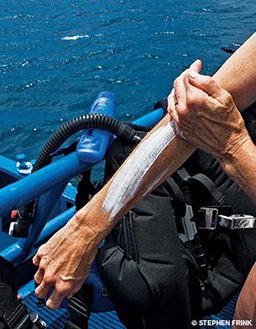
Coral reefs are the world’s largest biological constructions and are among the most beautiful ecosystems on Earth. They host a huge portion of the ocean’s biodiversity and are enormously valuable to humans both for tourism and the sustenance of coastal populations. They are the result of slow but progressive hard-coral growth, which over decades or centuries leads to established reefs.
Even in nutrient-poor waters, coral reefs can be miraculously productive. The corals grow through the activity of tiny algae, which live within the corals’ tissues and photosynthesize the sun’s light. The corals protect the algae and supply them with ammonium; the algae in turn release sugars and other organic nutrients that the corals use for food. These microscopic, pigmented algae, known as zooxanthellae, also confer color to the hard corals of the reef. The symbiosis with these algae is obligatory for tropical stony corals. If the algae die or are ejected from the corals (a phenomenon known as coral bleaching), the corals die almost immediately and, in most cases, without any chance of recovery. The loss of these algal symbionts means the loss of the engine that produces the corals’ food, and the corals become immediately vulnerable.
Reefs at Risk From Sunscreens
Many factors threaten corals, including physical damage from anchoring, fishing with explosives, excess heating of the ocean’s surface and pollution. Somewhat recently, a new emergency has been added to the list of the top-10 threats to coral reefs around the globe: sunscreens. Scientific investigations conducted at several reefs around the world — in the Caribbean, Fiji, the Red Sea and the Coral Triangle — indicate that the effects are almost immediate and generally lead to coral death within 48 hours.
The Need for Legislation
Unfortunately, adequate legislation is lacking in most countries, including the U.S. Before sunscreens can be sold, they must be shown to be dermatologically safe and to have an actual ability to protect the skin from UV light, but they are not subject to any environmental regulations. A notable exception to the lack of restrictions is in Mexico, where the use of sunscreens is banned in the cenotes (limestone caverns), which are popular with tourists.
Be Wary of “Safe” Sunscreens
A research team at the Polytechnic University of Marche in Ancona, Italy, tested several sunscreens, and all had significant impacts on marine life. Especially concerning are products that claim to be safe for corals because they are biodegradable. These products confound consumers by suggesting that biodegradable is equivalent to environmentally friendly, but this is not the case. Even products that degrade rapidly in seawater remain in the system long enough to kill any corals they come in contact with. This was exactly the case with one product the team tested, and it’s one of many misleading claims or untruths that can be found on sunscreen labels. In some cases, products state they are nontoxic for corals and other marine organisms despite containing oxybenzone and/or other derivatives of benzene, which are hazardous to corals.
How to Recognize Safe Sunscreens
It is simple to determine whether a sunscreen is harmful to the marine environment: Ignore what is written on the front, turn over the package, and read the ingredients. First note the presence of preservatives, then go through the list of chemical UV filters. The sunscreen is lethal for the corals and should be avoided if the product contains parabens (common preservatives such as butylparaben) or any of the following chemical filters:
- BMDBM (4-tert-butyl-4-methoxydibenzoylmethane benzophenone
- BZ (benzophenone-3)
- MBC (4-methylbenzylidene camphor)
- OMC (ethylhexyl methoxycinnamate)
- OCT (octyl methoxycinnamate)
- BEMT (bis-ethylhexyloxyphenol methoxyphenyl triazine)
- any component that includes the term –benzene
Caring for Our Skin

Now that scientists have identified the dangerous components in sunscreens, new products that are completely safe for the environment can be produced. Some manufacturers have attempted to make more environmentally friendly sunscreens through the use of physical filters (such as zinc oxide and titanium oxide), but studies of these are providing conflicting results. Some products containing zinc and titanium oxides have been shown to be harmful to corals, which in some cases show bleaching even after sort-term exposures. We are currently trying to understand the mechanisms underlying these effects.
After the impact of sunscreen on corals was discovered, a French company developed a sunscreen called Evoa that was tested and certified to be safe for corals. More recently, a sunscreen containing a new generation of ecofriendly filters has come onto the market, and corals treated with this sunscreen were apparently healthier than those in the control tanks. London-based Aethic has patented this novel composition, called Aethic Sôvée, which is available for purchase at www.aethic.com.
Take care of your skin and the environment by using hats, clothing, wetsuits, rash guards and/or sunscreens that are actually safe for corals instead of sunscreens that threaten reef health. According to marine scientist and conservationist Sylvia Earle, “In the grand scheme of things, sunscreen may be low on the list of things that corals need to worry about, but it may be one critical cut among the thousands that are stressing reefs and other ocean systems — just one more thing on top of all the rest that could send an ecosystem over the edge.” And unlike most other threats to the world’s corals, this is one that individual divers can do something about.
Reference
Danovaro R, Bongiorni L, Corinaldesi C, et al. Sunscreens cause coral bleaching by promoting viral infections. Environ Health Perspect. 2008 April; 116(4): 441–447. Available at: http://www.ncbi.nlm.nih.gov/pmc/articles/PMC2291018/. Accessed: Dec. 16, 2013.
© Alert Diver — Q1 Winter 2014